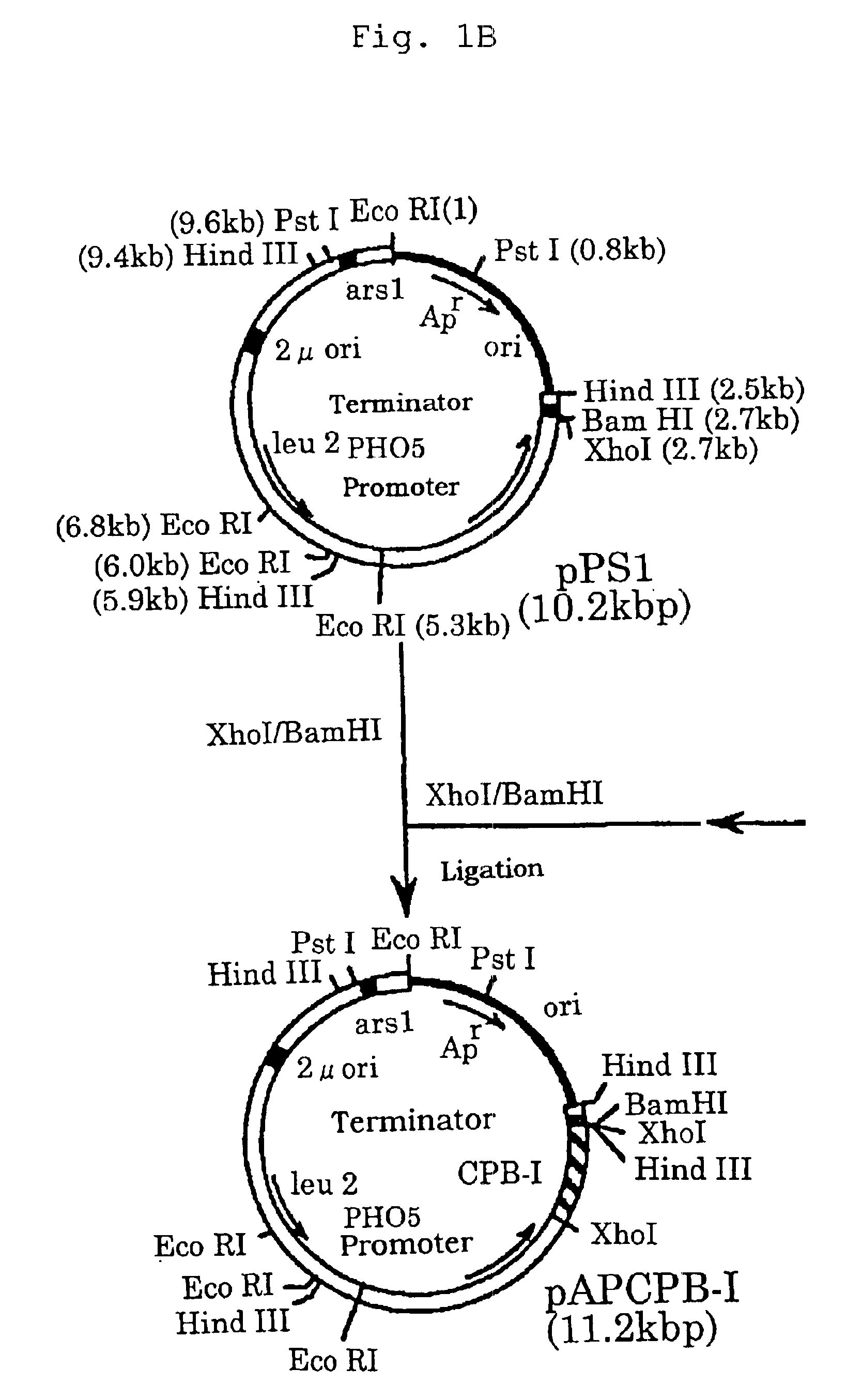Method of purifying calcium ion-binding protein
a technology of calcium ion-binding protein and purification method, which is applied in the direction of peptide/protein ingredients, peptide sources, lipocortins, etc., can solve the problems of labor and time, suitable purification, and conventional processes that are problematic in view of cost, efficiency and handling, and achieves simple and efficient methods.
- Summary
- Abstract
- Description
- Claims
- Application Information
AI Technical Summary
Benefits of technology
Problems solved by technology
Method used
Image
Examples
example 1
Purification of Recombinant Annexin V
(1) Culture of Annexin V-Producing Recombinant Yeast Cells
Annexin V-producing recombinant yeast cells were cultured on 2L synthetic selection medium at 28° C. for 3 days. The recombinant yeast cells were then inoculated to 88L selection medium and cultured at 28° C. for 2 days. The recombinant yeast cells were then transferred to 810L semisynthetic medium (40 g sucrose, 5 g yeast extract, 5 g ammonium sulfate and 0.5 g magnesium sulfate septahydrate in 1L medium) and culture was continued at 28° C. for 24 hours.
(2) Pretreatment of Annexin V in Large Quantity Prior to Purification
The large culture solution was filtered with a 0.1 μm membrane filter to collect the recombinant yeast cells, which were physically ruptured with a French press-type cell homogenater. The ruptured cell suspension was filtered with the membrane filter and the filtrate was concentrated with a ultrafiltrater. To the concentrate was added acetic acid for isoelectric precipita...
example 2
Purification of Recombinant Annexin V
A recombinant Annexin V was purified as in Example 1 except that 20 mM citrate buffer (pH 6.0) containing 20 mM calcium chloride and 50 mM sodium chloride was used in place of 20 mM ammonium chloride buffer (pH 9.0) containing 20 mM calcium chloride and 50 mM sodium chloride, and 20 mM citrate buffer (pH 6.0) was used in place of a linear gradient concentration of sodium chloride from 50 mM up to 300 mM with 20 mM ammonium chloride buffer (pH 9.0) containing 20 mM calcium chloride, in the cation exchange chromatography of the step (4). Flow rate was also altered to 15.6 to 54.6 cm / h at adsorption and 39 cm / h at elution.
FIG. 3 shows an elution pattern obtained by gel filtration chromatography of fractions eluted from cation exchange chromatography.
example 3
Purification of Annexin VT from Placenta
One placenta (about 500 g) excepting the amnion and an umbilical cord was sliced into pieces, washed with 2 L physiological saline, and minced with a meat grinder. After adding 400 mL of 50 mM Tris-HCl buffer (pH 7.4) containing 5 mM calcium chloride, 0.1% Triton X-100 and 5 mM benzamidine, the mince was homogenated with a whirling blender. The homogenate was centrifuged at 10,000 rpm for 20 minutes to collect precipitates, which were again suspended in 300 ml of 50 mM Tris-HCl buffer (pH 7.4) containing 50 mM EDTA and homogenated. The homogenate was again centrifuged at 10,000 rpm for 20 minutes and an extract of supernatant was recovered (about 300 mL), to which 63 g ammonium sulfate was added to prepare a 30%-saturated solution of ammonium sulfate. After centrifugation to remove precipitates, to the supernatant was added 54 g ammonium sulfate (60%-saturated ammonium sulfate) and precipitated Annexin VI fraction was recovered. Annexin V coul...
PUM
| Property | Measurement | Unit |
|---|---|---|
| pH | aaaaa | aaaaa |
| pH | aaaaa | aaaaa |
| pH | aaaaa | aaaaa |
Abstract
Description
Claims
Application Information
 Login to View More
Login to View More - R&D
- Intellectual Property
- Life Sciences
- Materials
- Tech Scout
- Unparalleled Data Quality
- Higher Quality Content
- 60% Fewer Hallucinations
Browse by: Latest US Patents, China's latest patents, Technical Efficacy Thesaurus, Application Domain, Technology Topic, Popular Technical Reports.
© 2025 PatSnap. All rights reserved.Legal|Privacy policy|Modern Slavery Act Transparency Statement|Sitemap|About US| Contact US: help@patsnap.com



